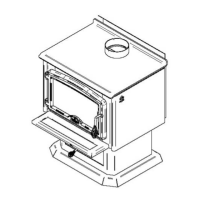Page 30
Installation and Operation Manual - 2000
ENGLISH
7. Clearances to Combustible Material
The clearances shown in this section have been determined by test according to procedures
set out in safety standards ULC S627 (Canada), UL 1482 (U.S.A.) and UL 737 (U.S.A.). When
the stove is installed so that its surfaces are at or beyond the minimum clearances specified,
combustible surfaces will not overheat under normal and even abnormal operating conditions.
No part of the stove or flue pipe may be located closer to combustibles than the minimum
clearance figures given.
7.1 Location of the Certification Label
Since the information given on the certification label affixed to the appliance always overrides
the information published, in any other media (owner’s manual, catalogues, flyers, magazines
and web sites) it is important to refer to it in order to have a safe and compliant installation. In
addition, you will find information about your stove (model, serial number, etc.). You can find the
certification label on the back of the stove.
We recommend that you note the stove serial number on page 5 of this manual since it will
be needed to precisely identify the version of the appliance in the event you require replacement
parts or technical assistance. It is also recommended to register your warranty online.
7.2 Clearances to Combustible Materials
The clearances to combustible walls may be slightly different in Canada and the U.S.A. and
may also differ depending on whether you use single or double wall flue pipe. Please be sure to
choose the correct clearance for your location and type of flue pipe.
The clearances of the appliance and the flue pipes must be met individually, meaning the
appliance can not be installed closer to the combustible materials than the single or double wall
pipe allows. For a safe way to reduce clearances refer to section «7.4 Reducing Wall and Ceiling
Clearances Safely»

